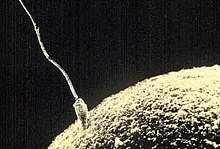Oogamy

Oogamyis a form ofanisogamywhere the gametes differ in both size and form. In oogamy the largefemalegamete(also known asovum) is immotile, while the smallmalegamete (also known assperm) is mobile.[1]Oogamy is a common form of anisogamy, with almost all animals and land plants being oogamous.
Oogamy is found in most sexually reproducing species, including all vertebrates, land plants, and some algae. The ancestral state of sexual reproduction is believed to be isogamy, with oogamy evolving through anisogamy. Once oogamy evolves, males and females typically differ in various aspects. Internal fertilization may have originated from oogamy, although some studies suggest[2]that oogamy in certain species may have evolved before the transition from external to internal fertilization. In streptophytes, oogamy occurred before the split from green algae.
Occurrence
[edit]Oogamy is found in almost all animal species thatreproduce sexually.[3][4]There are exceptions, such as theopilionesthat have immobile sperm.[5]
Oogamy is found in allland plants,[6]and in somered algae,brown algaeandgreen algae.[7]Oogamy is favored in land plants because only one gamete has to travel through harsh environments outside the plant.[8]Oogamy is also present inoomycetes.[9]
Etymology
[edit]The term oogamy was first used in the year 1888.[10]
Evolution
[edit]It is generally accepted thatisogamyis the ancestral state[11]and that oogamy evolves from isogamy through anisogamy.[12][13][14]When oogamy has evolved, males and females typically differ in many aspects. Oogamy evolved before the transition fromexternaltointernal fertilization.[15][non-primary source needed][4]
Instreptophytes,oogamy occurred before the split from green algae.[16]
See also
[edit]References
[edit]- ^Fusco, Giuseppe;Minelli, Alessandro(2019-10-10).The Biology of Reproduction.Cambridge University Press. pp. 111–112.ISBN978-1-108-49985-9.Retrieved29 March2021.
- ^Nozaki, H., Yamada, T. K., Takahashi, F., Matsuzaki, R., & Nakada, T. (2014). New "missing link" genus of the colonial volvocine green algae gives insights into the evolution of oogamy.BMC evolutionary biology,14(1), 37. https://doi.org/10.1186/1471-2148-14-37
- ^Bell, Graham(2019-11-28).The Masterpiece of Nature: The Evolution and Genetics of Sexuality.Routledge. p. 63.ISBN978-1-000-49744-1.
- ^abDusenbery, David B. (2009).Living at Micro Scale: The Unexpected Physics of Being Small.Harvard University Press. p. 326.ISBN978-0-674-06021-0.
- ^Leonard, Janet; Cordoba-Aguilar, Alex (2010-07-19).The Evolution of Primary Sexual Characters in Animals.Oxford University Press, USA. pp. 18–19.ISBN978-0-19-532555-3.
- ^Simpson, Michael G. (2010-07-19).Plant Systematics.Academic Press. p. 58.ISBN978-0-08-092208-9.
- ^Raven, Peter H.; Evert, University Ray F.; Evert, Ray F.; Eichhorn, Susan E.; Eichhorn, University Susan E. (2005).Biology of Plants.W. H. Freeman. p. 309.ISBN978-0-7167-1007-3.
- ^Raven, Peter H.; Evert, University Ray F.; Evert, Ray F.; Eichhorn, Susan E.; Eichhorn, University Susan E. (2005).Biology of Plants.W. H. Freeman. p. 376.ISBN978-0-7167-1007-3.
- ^Buaya, Anthony T.; Thines, Marco (2020)."An overview on the biology and phylogeny of the early-diverging oomycetes".Philippine Journal of Systematic Biology.14(1): 1-20.doi:10.26757/pjsb2020a14004.
- ^"Definition of OOGAMY".Merriam-Webster.Retrieved2021-09-14.
- ^Pitnick, Scott S.; Hosken, Dave J.; Birkhead, Tim R. (2008-11-21).Sperm Biology: An Evolutionary Perspective.Academic Press. pp. 43–44.ISBN978-0-08-091987-4.
- ^Kumar, Awasthi & Ashok.Textbook of Algae.Vikas Publishing House. p. 363.ISBN978-93-259-9022-7.
- ^Dusenbery, David B.; Dusenbery, Professor of Biology Emeritus David B. (2009).Living at Micro Scale: The Unexpected Physics of Being Small.Harvard University Press. p. 309.ISBN978-0-674-03116-6.
- ^Hörandl, Elvira; Hadacek, Franz (August 2020)."Oxygen, life forms, and the evolution of sexes in multicellular eukaryotes".Heredity.125(1): 1–14.doi:10.1038/s41437-020-0317-9.ISSN1365-2540.PMC7413252.PMID32415185.
- ^Nozaki, Hisayoshi; Yamada, Toshihiro K.; Takahashi, Fumio; Matsuzaki, Ryo; Nakada, Takashi (2014-03-03)."New" missing link "genus of the colonial volvocine green algae gives insights into the evolution of oogamy".BMC Evolutionary Biology.14(1): 37.Bibcode:2014BMCEE..14...37N.doi:10.1186/1471-2148-14-37.ISSN1471-2148.PMC4015742.PMID24589311.
- ^Geng, Sa; De Hoff, Peter; Umen, James G. (2014-07-08)."Evolution of Sexes from an Ancestral Mating-Type Specification Pathway".PLOS Biology.12(7): e1001904.doi:10.1371/journal.pbio.1001904.ISSN1544-9173.PMC4086717.PMID25003332.
